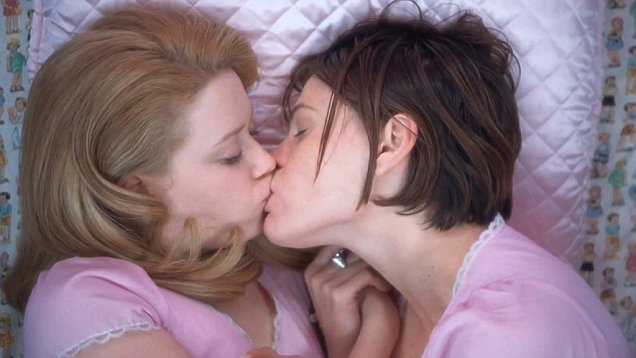Foreplay Is For Sissies: Queer Theorizing "But I'm A Cheerleader"
- emmaaikman
- Feb 9, 2021
- 4 min read
Updated: Apr 25, 2021
The 1999 film, But I’m a Cheerleader (Dir. Jamie Babbit), follows Megan (Natasha Lyonne) on her journey at “True Directions,” a conversion therapy camp dedicated to transforming homosexuals into “happy heterosexuals!” But as Megan tries to pray the gay away, her eyes are opened to the possibility of queer love, “falling in lesbians” with Graham (Clea DuVall). The pink and blue, A-frame, “True Directions” house is in itself a microcosm of the heteronormative world, actively shaping and governing the possibility of what bodies can do. Using evidence from three scenes, I’ll argue that the over-the-top set and costume design of But I’m a Cheerleader satirically exposes and comments on the absurdity of deeply entrenched heteronormativity.
In an effort to shape the surface of the trainee’s homosexual bodies, the women at True Directions are made to wear pink button-ups, sweaters, and hot pink skirts while the men must wear blue shorts, shirts, and ties. In order to not only shape the surface of their bodies, but what their bodies can do, the homosexuals must complete stereotypical, gendered tasks. Through montage, Jamie Babbit conveys the training program of the conversion therapy camp. The use of color, costuming, and set design within the montage works to expose the strictness of the gender binary and associated ideals. For example, Mary teaches the lesbians - who all wear dark green dresses - how to cross their legs properly. Some of the women struggle to sit how they are instructed to. In effect, compulsory heterosexuality disregards what bodies are inclined to do and instead forces them into a limiting mold of what their bodies must do. Green walls and the women’s dark green dresses in the scene also express additional codings; color theory associates green with wealth/money. Thus, the set design implicitly communicates that the ability to perform heterosexuality convincingly leads to a wealthy and prosperous life.

In the following scene of the montage, the lesbians wear aprons and green gloves to scrub the ground with tiny brushes while Mary wards over them. The hilariously small brushes expose the absurdity of the tasks and of gender roles in general. Next, Graham and Megan wash the dishes together. The tablecloth, tub of soap, gloves, and scrubbing brush are all a glaring pink. The garish, monochromatic set design is not “natural” but rather, draws attention to the absurdity of heteronormativity and related gendered behaviors. The ideal woman is not only heterosexual, but willing and wanting to clean and care for the home and children.
In a simulation on how to perform straight sex, the absurd costuming of the heterosexuals-to-be and gaudy set design reveals messaging that sex must not only be heterosexual and vaginal, but performed in a particular way as well. Clad in skin-tight, beige bodysuits with leaves covering their genitals, this costuming recalls imagery of Adam and Eve. Considered the father and mother of all human life, the costumes in this scene emphasize that heterosexual sex must first and foremost be procreative.
Additionally, the set design of the scene emphasizes the absurd and contrived workings of heteronormativity. Mary, from a director’s chair and with a megaphone, regulates and puppeteers the heterosexual actions of the “trainees” that lay on a gaudy, heart-shaped bed in front of her. She educates them, stating, “Foreplay is for sissies! Real men go in, unload, and pull out” (Babbit)!
As Mary suggests, the most ideal and privileged type of sex is sex that is not only heterosexual, but that is procreative and performed in missionary, with little thought given to foreplay or pleasure for the woman. Mary (ever-present in the background) and her subjects are a satirical microcosm of society’s governance of sexuality. Mary, with her director’s chair and megaphone, reflects the absurdity of society’s regulations on intimacy. Mary’s role as an overseer in this scene effectively limits what the trainees’ bodies can do. Additionally, The gaudy, heart-shaped bed also exposes the absurdity of compulsory heterosexuality through the juxtaposition of the trainee’s robotic actions with the “romantic” setting. The simulation is contrived and constructed, just like compulsory heterosexuality.
The last scene of the film, the graduation ceremony of the trainees from homo to hetero, evokes wedding imagery through the costuming, set, and prop design. Proud parents wearing white, line the pews as their newly heterosexual children walk down the aisle. One by one, they accept their graduation trophies, white statues of a man and woman holding hands. In this way, even the climax of the training program and film itself is tied to the institution of heterosexual marriage. Mary, positioned at the end of the aisle, assumes the role of a priest as she binds the graduates to heterosexual way of life.
As I’ve described, the overblown costuming of the film comments on the shaping and limiting of the trainee’s bodies - both of their surface and of their behavior. Dresses restrict movement, pink and blue costumes reinforce the gender dichotomy, Adam and Eve bodysuits demand procreative sex, and white wedding imagery reinforces the heterosexual coupling as ideal.


















Comments